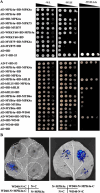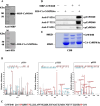The phosphorylation of a WD40-repeat protein negatively regulates flavonoid biosynthesis in Camellia sinensis under drought stress
- PMID: 38994448
- PMCID: PMC11237189
- DOI: 10.1093/hr/uhae136
The phosphorylation of a WD40-repeat protein negatively regulates flavonoid biosynthesis in Camellia sinensis under drought stress
Abstract
Flavonoids constitute the main nutraceuticals in the leaves of tea plants (Camellia sinensis). To date, although it is known that drought stress can negatively impact the biosynthesis of flavonoids in tea leaves, the mechanism behind this phenomenon is unclear. Herein, we report a protein phosphorylation mechanism that negatively regulates the biosynthesis of flavonoids in tea leaves in drought conditions. Transcriptional analysis revealed the downregulation of gene expression of flavonoid biosynthesis and the upregulation of CsMPK4a encoding a mitogen-activated protein kinase in leaves. Luciferase complementation and yeast two-hybrid assays disclosed that CsMPK4a interacted with CsWD40. Phosphorylation assay in vitro, specific protein immunity, and analysis of protein mass spectrometry indicated that Ser-216, Thr-221, and Ser-253 of CsWD40 were potential phosphorylation sites of CsMPK4a. Besides, the protein immunity analysis uncovered an increased phosphorylation level of CsWD40 in tea leaves under drought conditions. Mutation of the three phosphorylation sites generated dephosphorylated CsWD403A and phosphorylated CsWD403D variants, which were introduced into the Arabidopsis ttg1 mutant. Metabolic analysis showed that the anthocyanin and proanthocyanidin content was lower in ttg1:CsWD403D transgenic plants than ttg1::CsWD403A transgenic and wild type plants. The transient overexpression of CsWD403D downregulated the anthocyanidin biosynthesis in tea leaves. The dual-fluorescein protein complementation experiment showed that CsWD403D did not interact with CsMYB5a and CsAN2, two key transcription factors of procyanidins and anthocyanidins biosynthesis in tea plant. These findings indicate that the phosphorylation of CsWD40 by CsMPK4a downregulates the flavonoid biosynthesis in tea plants in drought stresses.
© The Author(s) 2024. Published by Oxford University Press on behalf of Nanjing Agricultural University.
Figures






References
-
- Hu H, Xiong L. Genetic engineering and breeding of drought-resistant crops. Annu Rev Plant Biol. 2014;65:715–41 - PubMed
-
- Lesk C, Rowhani P, Ramankutty N. Influence of extreme weather disasters on global crop production. Nature. 2016;529:84–7 - PubMed
-
- Zhuang J, Dai X, Zhu M. et al. Evaluation of astringent taste of green tea through mass spectrometry-based targeted metabolic profiling of polyphenols. Food Chem. 2020;305:125507. - PubMed
-
- Deng Y, Lu S. Biosynthesis and regulation of phenylpropanoids in plants. Crit Rev Plant Sci. 2017;36:257–90
LinkOut - more resources
Full Text Sources

